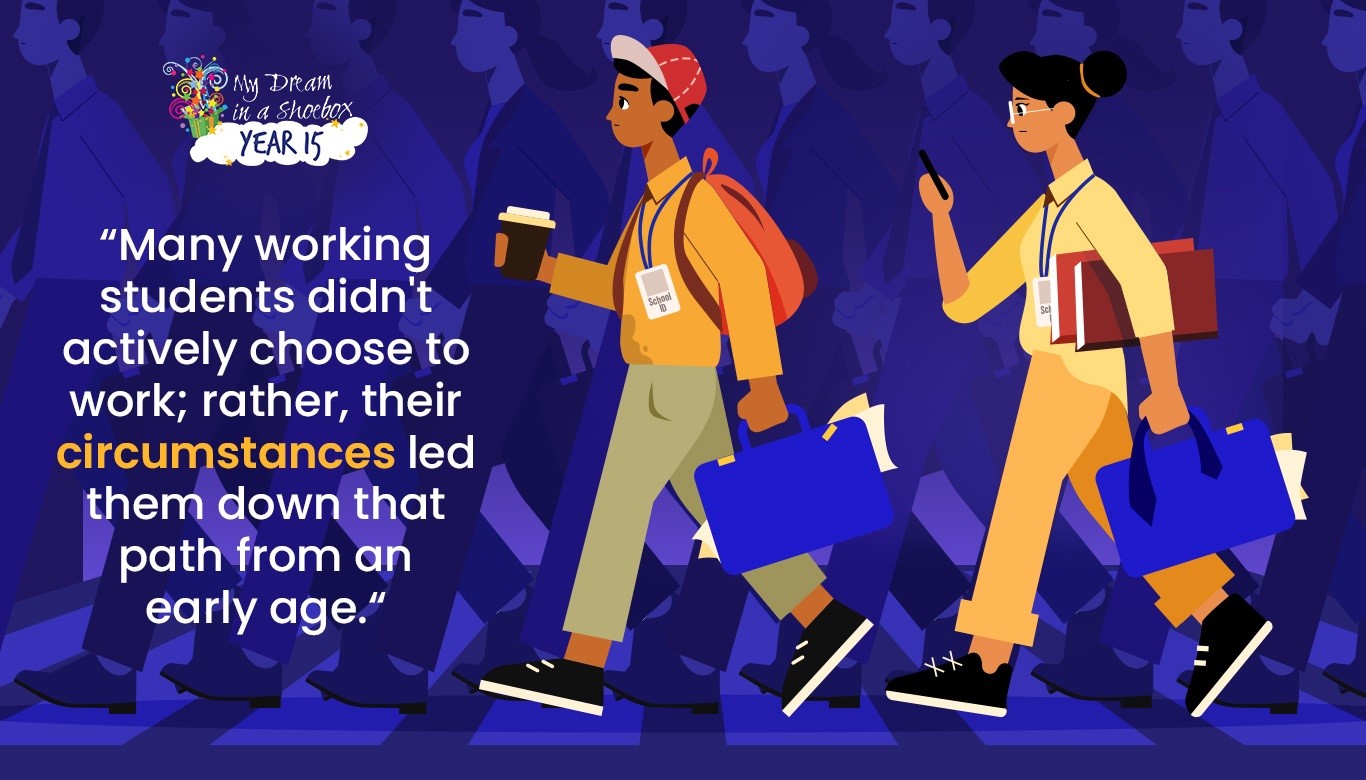Reasons Why Students Work While Studying in the Philippines

Working Students in the Philippines
The notion of working while studying isn’t new in the Philippines. Economic constraints often force Filipino students into the workforce early on. As a result, the current landscape sees a lot of students engaged in part-time or full-time work alongside their studies – making it difficult for students to juggle all at once.
According to the Commission on Higher Education (CHED), around 216,000 students in the Philippines work while studying. – that’s 8% of the total college population!
These young heroes juggle classes and jobs, balancing academic demands with long hours and demanding tasks like homework, reviews, and exams.
The reasons for working students go beyond just the rising cost of education. In some families, contributing financially is a cultural expectation, a way for young people to share the responsibility and lighten the load. For others, it’s a matter of pride, of proving their independence and building a future on their terms.
But for the most part, we can trace this back to the state of Education Poverty in the Philippines. Here are some factors that affect a student’s ability to pursue their education due to Education Poverty.
- Financial Limitations
For most families, this is the primary obstacle that stops children from getting a good education. They don’t have the privilege to send their kids to school, which hampers their growth. Some children even leave school early to begin working and help their families.
- Rising Inflation
As prices rise, so does the cost of education. For the past few years, tuition rates have risen gradually. From 10.49 percent in the academic year 2019-2020, the average tuition rate jumped to 12.06 percent from 2020 to 2021. This can be a significant hardship for students who are already struggling to make ends meet and one of the reasons students find themselves in a situation where they must work part-time to cover escalating school costs.
- Lack Of Government Investment In Public Education
For a large percentage of Filipino children, public schools remain the best option. Unfortunately, the government has failed to offer sufficient assistance to these organizations. Many obstacles have led to students and teachers needing to be able to effectively go about their classes, ranging from a lack of equipment to schools having to serve larger areas.
One might wonder why this journey of juggling books and jobs starts so early for Filipino students. Economic reasons play a crucial role. Families often rely on their children’s contributions to meet household expenses or support siblings’ education. As such, students willingly step into the workforce, driven by a deep-rooted sense of responsibility and determination to help their families.
Many working students begin young, working part-time as early as high school. This can be influenced by a variety of things, including:
- Supporting their families: From helping with household expenses to contributing to younger siblings’ education, these young earners play a vital role in their families’ well-being.
- Building self-reliance: Earning their own money fosters independence and a sense of accomplishment. It teaches them valuable life skills like time management, responsibility, and the importance of hard work.
- Investing in their future: Every peso earned is saved for college tuition, books, or even a small business venture. These young entrepreneurs are building their dreams brick by brick.
It’s Not So Much About “Who” And “When” But Rather About The “How”
Many working students didn’t actively choose to work; rather, their circumstances led them down that path from an early age. Often, these individuals come from environments where financial stability is a constant struggle. Growing up in families facing economic hardships, the necessity to contribute becomes ingrained in their lives early on.
They witness their guardians or parents working multiple jobs just to put food on the table or keep a roof overhead. In such environments, the idea of solely focusing on education is a luxury they cannot afford. For these students, work isn’t a choice but a means of survival, ingrained in their upbringing and molded by the realities of their circumstances.
How You Can Support Young Students
There is a chance for collaborative solidarity amid this reality. While the path of a working student may appear difficult, there are ways we can help these young people:
- Financial Aid and Scholarships:
Organizations and institutions can create tailored financial aid programs or scholarships specifically for working students. This support can alleviate their financial burdens and allow them to focus more on their studies.
- Community Support and Awareness:
Building awareness within communities about the challenges working students face can foster a more supportive environment. It encourages empathy and solidarity, prompting collective efforts to uplift these students.
Organizations like My Dream in a Shoebox are more than just financial aid providers; they also serve as community builders for the youth. They create a sense of belonging and foster a community of students who share similar aspirations. This sense of belonging can act as a tremendous motivation for students, helping them stay on course and achieve their objectives.
At My Dream in a Shoebox, our goal revolves around empowering underserved communities by providing crucial educational resources. Your contribution holds the power to support various initiatives, including Dream Kits, Educational Hubs, or scholarships, all aimed at arming students with the tools they need to excel in their education.
By donating to My Dream in a Shoebox, you wield the ability to select the avenue through which you’d like to make a difference:
- Dream Kits filled with essential school supplies, tools, and resources crucial for a student’s educational journey.
- Educational Hubs with functional laptops equipped with reliable internet connectivity and printing facilities.
- Scholarship Education Assistance sponsored for an entire year, laying the foundation for their academic success.
Join us in being a part of a larger movement. Sometimes, individual efforts may seem limited, but collectively, our commitment to giving back holds the potential to create a substantial and lasting impact for generations to come.

 facebook.com/mydreaminashoebox
facebook.com/mydreaminashoebox instagram.com/mydreaminashoebox
instagram.com/mydreaminashoebox